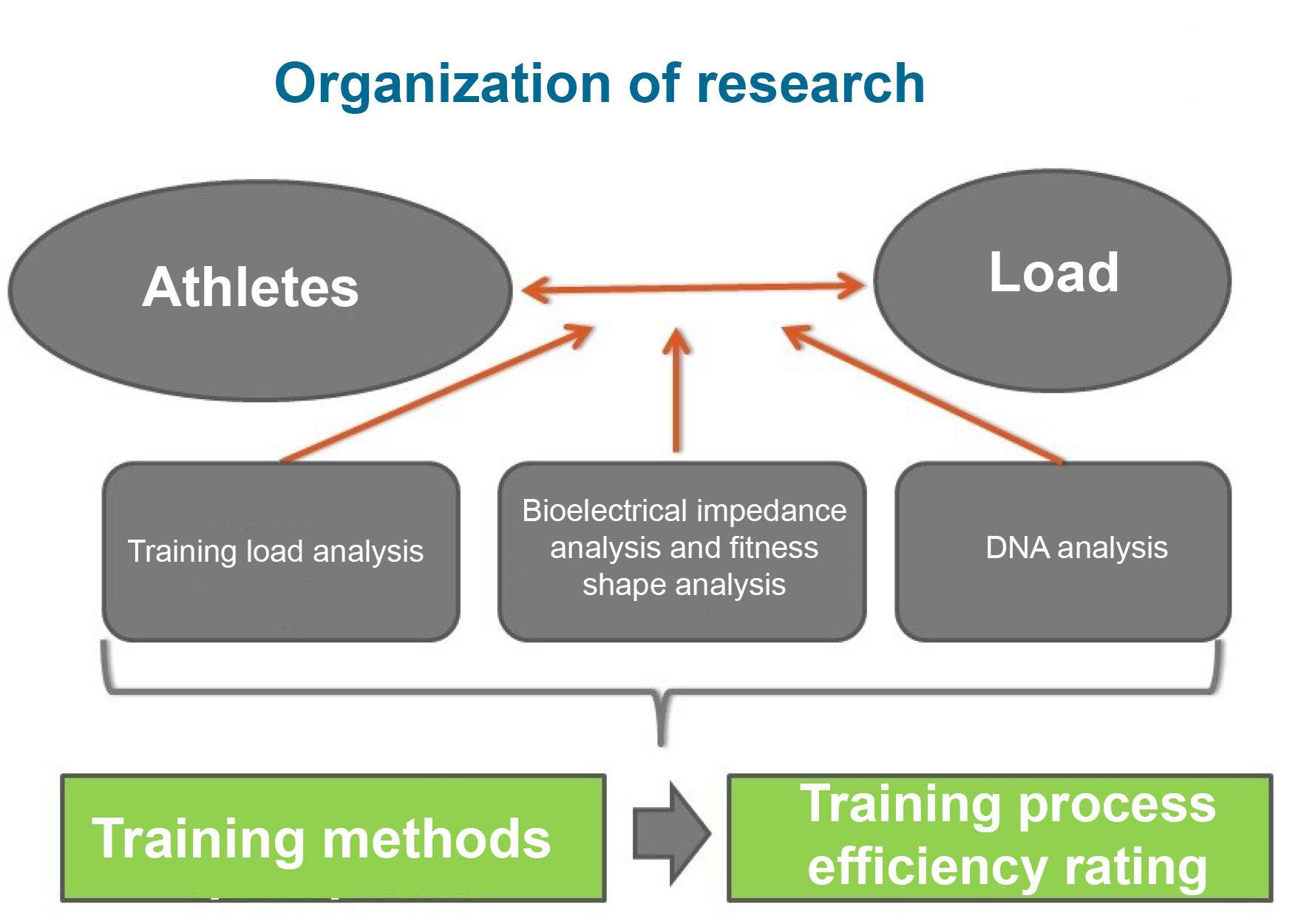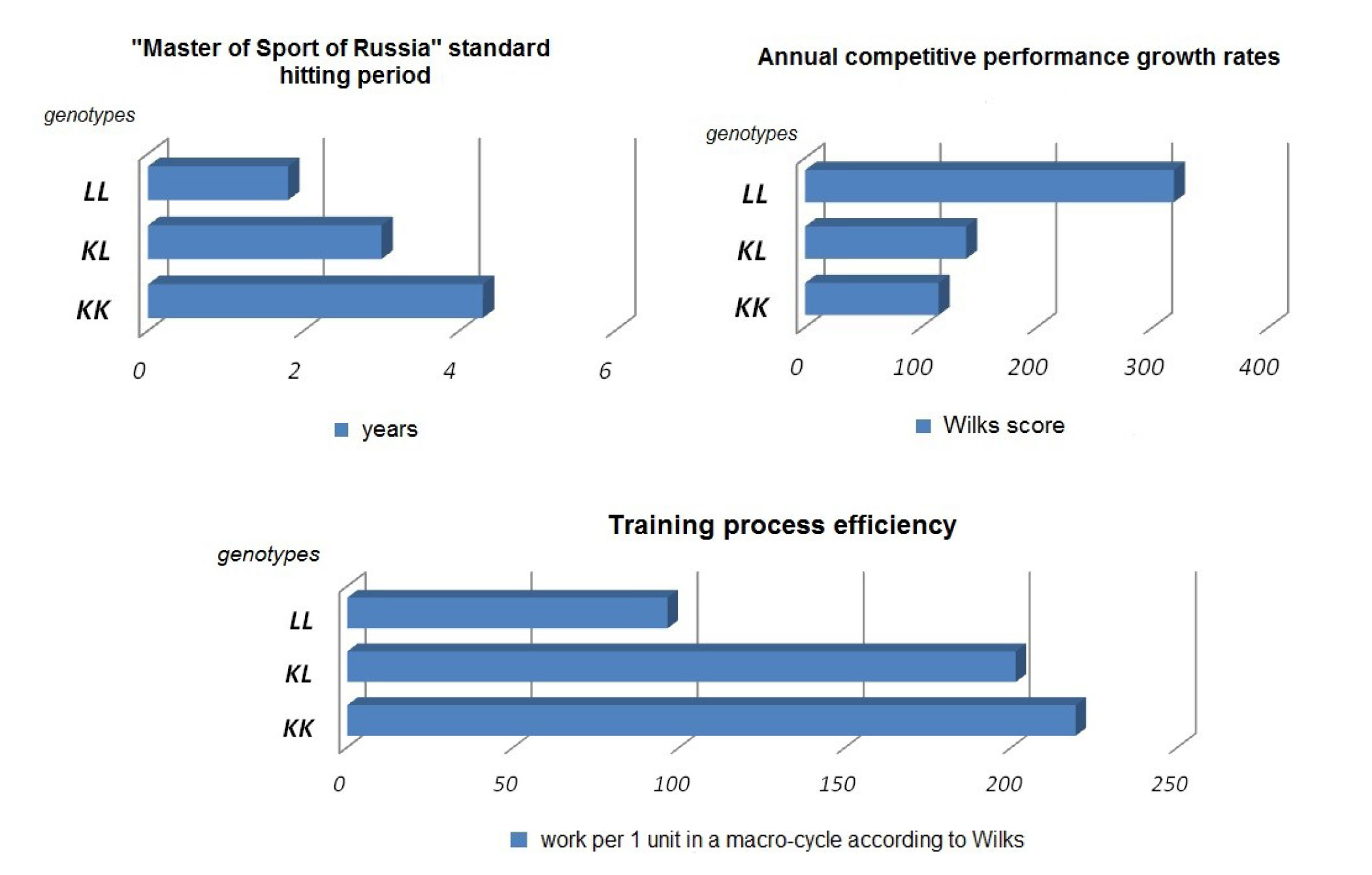Myostatin gene role in strength building process
Фотографии:
ˑ:
PhD, Associate Professor M.O. Aksenov1
Dr.Hab., Professor L.B. Andryushchenko1
1Plekhanov Russian University of Economics, Moscow
Keywords: genetics, strength qualities, extensity, intensity, training, weightlifting sports, macrocycle, myostatin, training process efficiency, trainability.
Introduction. Over the years, many researchers, coaches and even athletes have been giving special attention to the new technologies designed to improve the athletic strength building process efficiency [1, 2, 3, 7, 9-12].
Rapid development of the molecular-genetic methods made it possible to identify the genes affecting the level of athletic endowment in various sports. Development of scientific research in the field of strength sports was even more rapid, since strength, along with other physical qualities, is of great applied significance. Discovery of the "Myostatin" (MSTN) gene in 1997 led to a renewed interest in the issue [8].
Objective of the study was to identify special features of physical training of elite weightlifters with due regard to the MSTN gene.
Methods and structure of the study. In total, 178 Experimental Group athletes and 365 Reference Group athletes were under study. The Study Group (mean age 23.0±6.5 years, 81% males, 19% females) was represented by Masters of Sport of Russia (over 88%), International Class Athletes and Honored Masters of Sport (over 7%); as well as Candidate Masters of Sport and athletes with categories (not more than 5%). A computer program was designed to analyze the training process in weightlifting sports. Its target was to spare coaches and athletes the routine work associated with the training load calculations while planning and analyzing the training process. The computer program was registered with Rospatent (see Diagram) [6].

Diagram 1. Organization of research
The MSTN (rs1805086) genotypes were determined. The genotype frequency distribution among elite athletes was analyzed. The relationship of the target genotypes with the training process parameters was defined.
Results and discussion. The training process efficiency was studied based on the K153R mutation in the MSTN gene. We found that the presence of the L allele in elite weightlifters has a significant effect on the effectiveness of their training and competitive activities, as well as their training experience. Previous studies also prove the importance of the MSTN gene in the development of man’s strength qualities [3; 8]. In particular, it was found that further studies of the MSTN gene and eponymous protein could lead to the discovery of new, more effective training methods. Moreover, we proved that, in weightlifting sports, the MSTN gene is associated with the training loads when qualifying for Master of Sport of Russia.
Table 1. Analysis of athletic training process efficiency depending on MSTN genotypes
|
Gene |
MSTN |
||
|
Genotypes |
KK (n=120) |
KL* (n=4) |
LL (n=14) |
|
MS qualifying period (years) |
4.3±0.34 |
3.0±0.66 |
1.8±0.40 |
|
Competitive performance rates according to Wilks formula (units) |
495.4±11.40 |
417.33±0.88 |
572.7±17.30 |
|
Macrocycle load volume (barbell lifts) |
25272.75±1263.63 |
27977.63±1398.88 |
30682.5±1534.12 |
|
Annual competitive performance growth rates according to Wilks (units) |
115.21±18.06 |
139.00±5.57 |
318.17±90.85 |
|
Training process efficiency (work per 1 unit according to Wilks, annually) |
219.36 |
201.28 |
96.44 |
|
Significance level (р) |
<0.05 |
||
|
Gene contribution |
7.34% |
||
*р>0.05 – statistically insignificant inter-group differences.
Table 1 represents the results of the analysis of the training process efficiency in weightlifting sports depending on the MSTN genotype in athletes. More than 85% of the sampled population belonged to the KK genotype. At the same time, this genotype is associated with the low effectiveness of training of elite weightlifters, and is characterized by a longer period of qualifying for Master of Sports and low competitive performance growth rates. When assessing the training process efficiency by the ratio of the amount of load performed within the macrocycle versus the annual competitive performance growth rates, it was found that the average performance rate in the KK genotype athletes was =219.36 per unit of annual growth of competitive results, expressed in the Wilks coefficient. As compared to other genotypes of this gene, this indicator is the least advantageous, since the KK genotype subjects need more efforts to achieve higher competitive results. The heterozygous athletes are in a more favourable position regarding the effectiveness of their training activity within the macrocycle. Their competitive performance rates are comparatively low, at the level =417.33±0.88 units according to the Wilks formula, with the average training load volumes during the year. Nevertheless, the presence of the L allele in the myostatin gene gives them some advantage in the annual growth of their competitive performance rates, the annual average increment equaled =139±5.57 units according to the Wilks formula. It is against this background that we found the pre-season training process to be highly efficient. During the year, athletes carrying the KL genotype have a =201.28 barbell lift per each unit of competitive performance growth according to Wilks. This indicator is more advantageous in comparison with the KK monozygote and provides certain advantages in the competitive performance growth. We obtained the unique data when studying the rare LL genotype. Masters of Sport with this genotype demonstrated quite impressive results during training and competitions in weightlifting sports. Thus, these athletes become Master of Sport in record-breaking time, =1.8±0.40 years, their competitive performance records reached the absolute maximum, =572.7±17.30 units according to Wilks, the annual competitive performance growth rate were also at the maximum, top record level, =318.17±90.85 units. Calculation of the efficiency criterion revealed the most effective genotype in weightlifting sports, the training process efficiency for athletes carrying the LL genotype was on the average 96.44 lifts per unit of growth of competitive performance within the macrocycle (see Figure).
The accepted fact allows for the conclusion on a statistical significance at the level of p<0.05 with the gene contribution of 7.34%.

Therefore, when studying the LL monozygotes, special attention should be paid to 3 parameters: training experience, competitive performance rates and maximum achievements in weightlifting sports. The specified characteristics bring out the LL genotype as a marker of high training efficiency in weightlifting sports (see diagrams).
The LL genotype is characterized by the higher annual competitive performance growth rates, and its values are almost 2.5 times higher than those in the athletes carrying other MSTN genotypes. The low expression of MSTN enhances the training process efficiency in weightlifting sports. The data obtained on the KL heterozygote are statistically insignificant (p>0.05) due to the fact that this genotype is very rare and the sample size is not sufficient enough for a high significance level.
Conclusion. The MSTN genotypes to be considered the genetic markers for fast trainability in weightlifting sports based on the research findings are as follows: KL and LL.
The study was performed with the financial support from the Russian Foundation for Basic Research and the Republic of Buryatia under Project #18-413-030001.
References
- Aksenov M.O. Osnovy postroeniya trenirovochnogo protsessa v tyazheloatleticheskikh vidakh sporta s uchetom geneticheskikh osobennostey [Fundamentals of training process design in weightlifting sports based on genetic features]. Ulan-Ude: BSU publ., 2016, 259 p.
- Aksenov M.O. Assotsiatsiya gena ACTN3 s pokazatelyami bioimpedansnogo analiza vysokokvalifitsirovannykh sportsmenov tyazheloatleticheskikh vidov sporta [ACTN3 gene association with indicators of bioelectrical impedance analysis of elite athletes in weightlifting sports]. Teoriya i praktika fiz. kultury, 2016, no. 2, P. 80.
- Aksenov M.O., Andryushchenko L.B., Averyasova Yu.O. Poisk genov vliyayuschikh na effektivnost sorevnovatelnoy deyatelnosti basketbolistov [Search for genes of influence on competitive efficiency of basketballers]. Mater. II Vseros. nauch.-prakt. konf. po voprosam sportivnoy nauki v detsko-yunosheskom i adaptivnom sporte [Proc. II nat. res.-pract. conf. on the issues of sports science in children and youth and adaptive sports], 11-13 December 2017, P. 12
- Andryushchenko L.B., Averyasova Yu.O. Organizatsionno-metodicheskie osobennosti otbora basketbolistov v rezervnye sbornye komandy Rossii [Organizational and methodological features of qualification of basketball players to reserve teams of Russia]. Mater. II Vseros. nauch.-prakt. konf. po voprosam sportivnoy nauki v detsko-yunosheskom i adaptivnom sporte [Proc. II Rus. res.-pract. conf. on the issues of sports science in children and youth and adaptive sports], 11-13 December 2017, p. 14.
- Bompa T., Buzzichelli K. Periodizatsiya sportivnoy trenirovki [Periodization training for sports]. Proc. II Rus. res.-pract. conf.. Moscow: Sport, 2016, 384 p.
- GMA. Geneticheski modifitsirovannye sportsmeny [Videofilm]: nauch.-pop. film [GMA. Genetically modified athletes. [Video]: scientific-pop. film]. L. Gena, R. Abida. France: Art France Film Company and the National Center for Cinematography of France, 2002. Available at: https://www.youtube.com/watch?v=bD0Z40oWkFQ (Date of access: 04.02.2018 g.). Transl. from Fr. 2012.
- Roger W. Earle, Thomas R. Baechle Osnovy personalnoy trenirovki [Essenials of personal training]. Transl. from Engl. I. Andreev. Kiev: Olimp. lit. publ., 2012, 724 p.
- Aksenov M.O. Patent RF no. 2016610865, 21.01.2016. Kompyuternaya programma «Sport 3.0». Rospatent no. 2016610865, 2016 [The patent of the Russian Federation no. 2016610865, Jan 01, 2016. Computer program "Sport 3.0". Rospatent no. 2016610865, 2016].
- Platonov V.N. Periodizatsiya sportivnoy trenirovki. Obschaya teoriya i ee prakticheskoe primenenie [Periodization of sports training. General theory and its practical application]. Kiev: Olimp. lit. 2014, 624 p.: il. Ref.: pp. 588-613. Al. in.: pp. 614-623.
- Roman R.A. Trenirovka tyazheloatleta [Weightlifter training]. 2nd ed., rev, sup.. Moscow: Fizkultura i sport publ., 1986, 175 p.
- Shishkin S.S. Miostatin i nekotorye drugie biokhimicheskie faktory, reguliruyuschie rost myshechnykh tkaney u cheloveka i ryada vysshikh pozvonochnykh [Myostatin and some other biochemical factors regulating muscle growth in humans and some higher vertebrates]. Uspekhi biologicheskoy khimii, 2004. vol. 44, pp. 209-262.
- Gineviciene V., Jakaitiene A., Aksenov M.O., Aksenova A.V., Druzhevskaya A.M., Astratenkova I.V., Egorova E.S., Gabdrakhmanova L.J., Tubelis L., Kucinskas V., Utkus A. Association analysis of ACE, ACTN3 and PPARGC1А gene polymorphisms in two cohorts of European strength and power athletes. Biology of Sport, vol. 33, no. 3, pp. 199–206.
Corresponding author: maxim.axjonow@mail.ru
Abstract
The study considers the role of myostatin gene (MSTN) in strength building in competitive sports, with the competitive performance rated versus MSTN genotypes. The study team developed a software to analyze the training process scopes for different sport disciplines (Patent #2016610865 of 21.01.16) and applied the software to design a training load profiling database for combat sports. Subject to a genotyping exercise under the study were the elite athletes (n=178) specializing in modern weightlifting sports including powerlifting, weightlifting, arm-wrestling, bench press, dumbbell etc. The study data were applied to make practical recommendations on how the training systems applied by the Russian national powerlifting team could be improved. The study team offered the training load control and annual macrocycle intensity step increase scenarios customized to individual MSTN genotypes.




